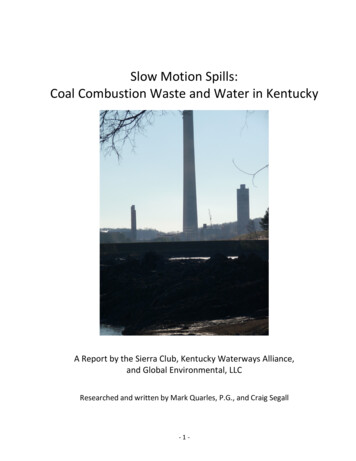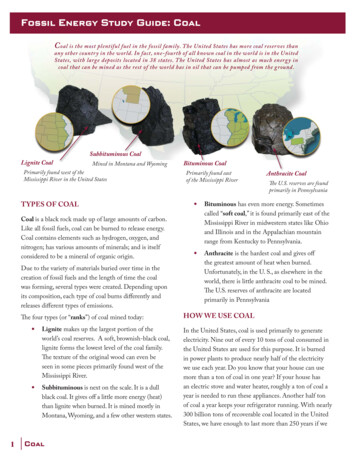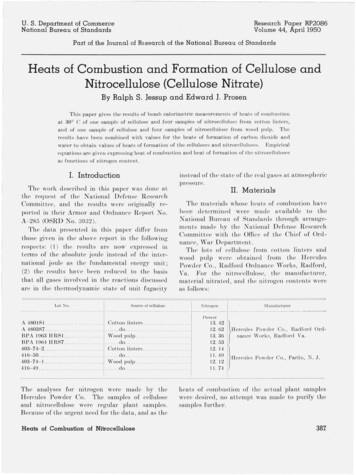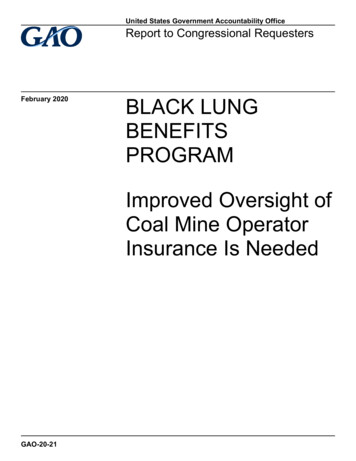
Transcription
Slow Motion Spills:Coal Combustion Waste and Water in KentuckyA Report by the Sierra Club, Kentucky Waterways Alliance,and Global Environmental, LLCResearched and written by Mark Quarles, P.G., and Craig Segall-1-
Slow Motion Spills:Coal Combustion Waste and Water in KentuckyA Report by the Sierra Club, Kentucky Waterways Alliance, and Global Environmental, LLCResearched and written by Mark Quarles, P.G., and Craig Segall1Quiet Leaks, Big ProblemsIn December 2008, a coal combustion waste pond in Kingston, Tennessee burst. Over 1 billiongallons of sludge poured out, burying houses and rivers in tons of toxic waste charged with heavymetals like mercury and arsenic. That disaster made headlines around the country – and still isn’tcleaned up today. Kentucky isn’t immune to big spills. In fact, EPA has identified six ponds inKentucky that would pose a high hazard to human life should they fail.2 But huge accidents aren’tthe only problem coal combustion waste or “CCW”3causes. Every day in Kentucky, ponds andlandfills leak into our groundwater and rivers, seeping out a slow-motion flood of contamination. Asthis report shows, every site in Kentucky for which groundwater data was available appears to beleaking. Kentucky is failing to control coal combustionwaste contamination.Coal combustion waste is a national problem. Everyyear, coal plants across the country produce over 130million tons of waste, laden with hazardous chemicals,including arsenic, boron, cadmium, chromium, lead,mercury, selenium, and thallium. Some of this waste isstored in landfills, which often are unlined or poorlydesigned. Often, wet ponds – colloquially referred to asash ponds or CCW ponds – are used. These ponds,generally unlined, pose particularly acute water risks.Chemicals leaching from CCW in landfills or ponds canAfter the Kingston spill.cause organ damage and cancer and many arePhoto courtesy Lyndsay Moselely.connected with brain damage in children. Because thefederal Environmental Protection Agency (EPA) does not yet regulate coal combustion waste, and1Mark Quarles, P.G., is a licensed professional geologist in Tennessee and is the principal of Global Environmental, LLC.Craig Segall is an environmental law fellow with the Sierra Club Environmental Law Program.2See EPA Fact Sheet: Coal Combustion Residue – Surface Impoundments with High Hazard Potential Ratings (listingfacilities in Harrodsburg, Ghent, and Louisville, Kentucky).3“Coal combustion waste” is a broad term. This report uses it to include bottom and fly ash from traditional coal plantsalong with sludge from coal plant scrubber systems and slag from coal gasification plants, among other waste products.-2-
most states don’t fill the gap, power companies are largely free to dispose of their waste how, andwhere, they like.That casual and dangerous practice has damaged the water of more than a hundred communities.4EPA’s own damage reports – which only describe a few examples of a national problem -- make forharrowing reading. In Virginia, for instance, CCW dumping turned water green in nearby residences– and filled that water with toxic selenium.5 High levels of arsenic also fouled groundwater and anearby stream. In South Carolina, a leaking old ash pond was replaced with a new pond – which stillleaked so badly that arsenic levels in groundwater spiked above human health limits.6 In NorthCarolina and Texas, selenium from CCW crept into the flesh of fish in lakes and reservoirs.7 And inIndiana, where power plants dumped 1 million tons of ash in and around the town of Pines, wellwater turned foul and turned out to have elevated levels of arsenic, lead, and cancer-causingbenzene.8Kentucky has 44 ashponds, the secondmost in the nationafter Indiana Kentucky barelyregulates thesesites.Is the past prologue for Kentucky? Kentucky has 44 ash ponds, thesecond most in the nation after Indiana,9 and dozens of coal combustionwaste landfills and dumpsites – and it barely regulates these sites. TheSierra Club and Kentucky Waterways Alliance, working with GlobalEnvironmental, LLC, launched an investigation into the commonwealth’sown records to find out what coal combustion waste is doing toKentucky’s water. We found grim news. Although records are spotty,every one of the sites for which data were available has groundwatercontamination consistent with coal combustion waste and, in manyinstances, this contamination is getting worse.The InvestigationWe set out to examine groundwater records for CCW sites throughout Kentucky. Using KentuckyOpen Records Act requests, we reviewed monitoring records held by the Kentucky Division of WasteManagement. We were interested in records for both dry landfill sites and CCW disposal ponds.We focused particularly strongly on pond disposal sites because, although both dry landfills andponds can leach poisons into water, unlined CCW ponds pose an extreme threat to Kentucky’swater, as they place huge volumes of wet sludge directly above groundwater, with no barrier inbetween. Eventually, we received monitoring data for 8 sites, covering a range of ponds and drylandfills.4See EPA, Coal Combustion Waste Damage Case Assessments (2007) (listing 71 potential or proven damage cases);Earthjustice & Environmental Integrity Project, Out of Control: Mounting Damage from Coal Ash Waste Sites (2010)(describing an additional 31 sites).5EPA, Coal Combustion Waste Damage Case Assessments at 14-16 (2007)6Id. at 24-25.7Id. at 25, 33-34.8Id. at 32-33.9See Jim Bruggers, KentuckianaGreen.com, Here are the Rankings (Sept. 1, 2009) (Louisville Courier-Journal compilationof EPA data).-3-
The Division of Waste Management’s staff was very helpful, but it soon became clear that theDivision’s records are far from complete and well-organized. Of the 44 ponds in Kentucky, we wereable to turn up information on only 8 sites. Even for those 8 sites, Kentucky did not have monitoringrecords for all CCW contaminants. In some cases, the Division had even allowed sites whose earlyrecords showed dangerous levels of toxic heavy metals to stop monitoring for those pollutants.Worse, the Division generally does not require specific monitoring sites near ponds, which areespecially leak-prone. As a result, we were able to secure data associated with ponds only where afacility happened to have installed monitoring wells for a landfill, and those wells were placed inways that allowed us to analyze pond contaminants. Finally, even more troubling, the Division oftenlacked even basic maps showing where monitoring wells were – meaning that, without following up,Division of Waste Management staff members are forced to rely upon company’s characterizationsof how wells are placed within a groundwater system, rather than being able to see for themselves.Despite these limitations, the state’s data still contained strong evidence of contamination, as wedescribe below. It is striking – and unfortunate – that the records documenting this importantproblem are so limited. Although it is possible that the Division’s databases may hold informationfor other sites, which we did not obtain, the generally incomplete nature of records in this areasuggests that Kentucky is not approaching the problem with sufficient seriousness.The ResultsEven with the limited data the Division of Waste ManagementWe receivedcould provide, signs of CCW contamination are unmistakable.groundwater monitoringAt each site, the chemical signature of leaking coal combustiondata from eight powerwaste appears in the water, with pollutant levels that can behundreds of times over levels EPA has determined to be safe.plants in Kentucky. AllTo be clear: while the data are imperfect, due to flawed stateeight sites weremonitoring practices, the compounds fouling water beneathcontaminated.these sites very likely came from coal combustion waste. Thisis not a subtle problem. Coal combustion waste appears to be contaminating water acrossKentucky.We received groundwater monitoring data from eight power plants in Kentucky. All eight sites werecontaminated. The plants are: Cane Run Station near Louisville, owned and operated by E.On and Louisville Gas & ElectricEast Bend Station near Rabbit Hash, owned and operated by Cincinnati Gas and Electric andDuke PowerR.D. Green Station near Robards, owned and operated by Big Rivers Electric CorporationParadise Station near Drakesboro, owned and operated by the Tennessee Valley AuthorityTrimble County Station near Louisville, owned and operated by E.On and Louisville Gas &Electric-4-
Shawnee Station near Paducah, owned and operated by the Tennessee Valley AuthoritySpurlock Station near Maysville, owned and operated by the Eastern Kentucky PowerCooperativeD.B. Wilson Station near Centertown, owned and operated by Big Rivers Electric CorporationWe assessed environmental issues at these sites by relying on EPA’s methods. EPA recognizes“proven damage cases” – instances where coal combustion waste has harmed water quality –where a plant causes violations of the Safe Drinking Water Act’s primary standards, which aredesigned to protect human health and the environment, and polluted water is migrating away fromthe site. These primary standards, called “maximum contaminant levels” or “MCLs,” are set forheavy metals found in coal combustion waste. EPA recognizes “potential” damage cases whereeither primary MCLs have been violated but there is not evidence that pollution has migrated, orwhere there are violations of secondary MCLs, which are set to protect public welfare.10Each of these plants is, at a minimum, a potential damage case. Because Kentucky does not havemonitoring data tracking how far pollutants have migrated, and sometimes did not have data forpollutants covered by primary MCLs, it’s difficult to determine whether the plants are provendamage cases. Further, because these sites often have massive waste complexes, covering acresand containing both ponds and landfills, and companies often did not submit detailed groundwaterdiagrams or surface maps, it is sometimes hard to tell which component of the waste facility iscausing pollution. Nonetheless, the available data do point to onsite CCW contamination and thedegree of contamination strongly suggests that pollutants are making their way off site.Indeed, EPA has already confirmed that one of these Kentucky facilities -- East Bend -- is, at theleast, a potential damage case.11 Notably, EPA’s analysis focused on iron, dissolved solids, andsulfates leaking from the site, which were alone sufficient for it to make its case. Its report did notinclude some of the heavy metals we found in earlier groundwater monitoring data for that site,and which suggest even more substantial damage, as we discuss in a site-specific review later in thisreport. EPA’s decision thus suggests the stronger evidence gathered in our file review warrantssimilar designations for the other facilities we reviewed, which have similar or more severe leaks.Based upon our review of these sites, we drew three primary conclusions:1. Existing data point to groundwater contamination caused by coal combustion wastebeneath every plant we studied. For many sites, contamination is intensifying as CCWcontinues to build up in ponds and landfills.2. Kentucky’s regulatory program is not properly addressing this threat; instead, it’s gettingweaker. Even as evidence of contamination mounted in state files, Kentucky reducedmonitoring requirements, failed to commence enforcement action, and continued topermit new ponds and landfills without proper controls.1011See generally EPA, Coal Combustion Waste Damage Case Assessments (2007).See id. at 43 (describing leaks to the Ohio River from the East Bend site).-5-
3. Kentucky is not comprehensively tracking where CCW contamination is going, putting offsite drinking water and communities at risk and allowing CCW discharges to enter ourrivers and streams. Because heavy metals found in CCW waste are toxic in extremely lowconcentrations, and many of these metals accumulate over time, the combination ofinformation gaps and leaky CCW sites is very dangerous.Our detailed results appear in the summary table below and in the plant-by-plant data attached tothis report.It is clear that something is badly wrong with the water under these waste facilities, and that thepollutants in that water are consistent with coal combustion waste contamination. Highlights of ourfindings include the following:Clear Contamination Total dissolved solids (TDS), chlorides, iron, and/or sulfate parameter concentrationsindicate groundwater contamination at every site. TDS, chlorides, iron, and sulfates areknown to be good indicators of coal combustion wastes in groundwater and surface water.Every site that tested for heavy metals and reported the data to the Division of WasteManagement had metal concentrations that exceeded state and EPA drinking waterstandards (e.g. Duke Energy East Bend; EKPC Spurlock; TVA Shawnee; Big Rivers D.B. Wilson;Big Rivers R.D. Green). In some cases, metals contamination is more than a hundred timesover drinking water standards.CCW ponds are clearly leaking into the groundwater beneath them, as every pond for whichdata were available was associated with contamination (e.g. LG&E Trimble Station; DukeEnergy East Bend).Groundwater contamination problems are becoming more acute with time at many sites,presumably due to long-term leakage (e.g., TVA Paradise, TVA Shawnee, Big Rivers D.B.Wilson).Compacted clay-liners have proven ineffective at preventing contaminant migration fromthe “dry” waste disposal in landfills (e.g. EKPC Spurlock Station).Coal combustion wastes are placed in unlined landfills on un-reclaimed mine spoil sites inclose proximity to rivers, and there is no meaningful soil barrier on the spoil to provide anypollutant attenuation (e.g. Big Rivers D.B. Wilson Plant).Failed Oversight Ash ponds are not monitored statewide even though data clearly indicate leakage resultingin contamination of groundwater (e.g. LG&E Trimble Station; Duke Energy East Bend). Ashponds are extensive in acreage (up to ¾-mile long) and are located adjacent to major riversand small tributary streams (e.g. EKPC Spurlock Station; LG&E Trimble Station).-6-
Groundwater monitoring programs dating to the 1980s and mid-1990s were more stringentbecause metals testing was required. The Division of Waste Management discontinuedmetals testing in 1997 / 1998, even though contamination above regulatory standardsexisted dating to the 1980s (e.g. Duke Energy East Bend, Big Rivers D.B. Wilson and R.D.Green Plants).No surface water, fish and aquatic life, or sediment monitoring is required even wherecontaminated groundwater is expected to discharge to a receiving stream (e.g. LG&E TrimbleStation; LG&E Cane Run).Statistical analyses of groundwater data are not always required and even when required,are not always performed by the owner (e.g. LG&E Trimble Plant; EKPC Spurlock).The Division of Waste Management does not require that potentiometric surface diagramsfor each groundwater monitoring event be prepared, even though the owner already hasthe information necessary to prepare such a map. As a result, neither the Division nor theplant owner knows with certainty the rate or direction of groundwater flow that are criticalto determine migration pathways and risks. Instead, plant owners report wells as“upgradient”, “downgradient” or “sidegradient,” and Division staff must take companies’word for it if they do not conduct further research.In fact, even basic maps showing the location of monitoring wells were missing from somefiles.Continuing Pollution Unlined disposal sites that the Division of Waste Management continues to approve aretypically located adjacent to receiving streams where shallow groundwater is expected.Many ash ponds are not lined and expansions of unlined ponds continue – even thoughgroundwater data at expansion sites indicate contamination of groundwater (e.g. LG&ETrimble).Recent unlined, horizontal expansions of permit-by-rule landfills continue even though thereis clear evidence of leakage resulting in groundwater contamination, and/or the “horizontalexpansions” are not contiguous on power plant properties (e.g., TVA Shawnee; Big RiversD.B. Wilson Plant; LG&E Cane Run Station).Kentucky’s failure to control metal discharges is particularly troubling. Monitoring groundwater andsurface water for metals, and controlling these discharges, should be of utmost importance toKentucky because these substances can be extremely harmful at very low concentrations. Asummary of the metals detected above regulatory standards at one or more of the power plantsites and their known harm is below. Importantly, these metals may not produce these results inevery case: not everyone responds in the same way to pollution. But it is clear that even very smallconcentrations of these pollutants can make people sick. Indeed, EPA studies have found thatcancer risk for well users living near leaking CCW sites can increase dramatically.1212See EPA, Draft Human and Ecological Risk Assessment of Coal Combustion Wastes (Aug. 6, 2007); See also Earthjustice& Environmental Integrity Project, Coming Clean: What the EPA Knows About the Dangers of Coal Ash (May 2009).-7-
Metals and Their niumEffectHuman carcinogen (0.01 mg/L MCL)Nausea, vomiting, and throat ulcer (2.0 mg/L EPAlong-term child health advisory average)Kidney, lung, and bone damage (0.005 mg/L MCL)Kidney damage, high blood pressure, anddevelopment delays for children (0.015 mg/L MCL)Kidney damage (0.002 mg/L MCL)Hair and fingernail loss (0.05 mg/L MCL)Fish and aquatic life toxicity (0.020 mg/L acutetoxicity, 0.005 mg/L chronic toxicity, 401 KAR,10:031)Toxins leaching from CCW can also cause substantial environmental harm. Heavy metals thatslowly accumulate in the food chain are particularly dangerous, and may be toxic at extremely smallconcentrations. EPA, for instance, recommends that states set water quality limits to ensure thatecosystems are not exposed to chronic levels of more than just 0.77 micrograms of mercury per liter– that is, 0.00000077 grams – or more than 5 micrograms per liter of selenium.13 Long term leaksfrom CCW sites can push ecosystems above such limits, leading to lasting harm to rivers andstreams.14The conclusion is simple: Kentucky has failed to control coal combustion waste pollution and thatpollution is dangerous.13See EPA, National Recommended Water Quality Criteria, available e/.14See, e.g., A. Dennis Lemly, Aquatic Exposure to Selenium is a Global Environmental Safety Issue, 59 Ecotoxicology andEnvironmental Safety 44 (2004) (observing that coal ash may have as much as 1250 times the selenium that unburnedcoal does and listing “locations where selenium pollution has contaminated fish and wildlife populations”).-8-
Table 1 - Summary of Findings - Coal Combustion Waste Monitoring – All SitesSite /OwnerCG&EDukeEnergyEast ax. MCL exceedance)9 wells (of 10) exceededat least 1 std. from1981 to 1997SMCLExceedance (Max.SMCL exceedance)9 wells (of 10)exceeded at least 1std. from 1981 to1997Iron – 1.5 times std.ProximityTo StreamNo metals analysesrequired since 1997CCW LandfillYesUnknownArsenic – 4 times std.Mercury – 300 timesstd.Sludge PondUnknown UnknownLead – 1.6 times std.Mercury – 450 timesstd.Iron – 43 times std.Silver – 66 times std.300 ft.Ohio RiverMercury – 450 timesstd.Iron – 28 times std.400 ft.Ohio RiverAsh PondUnknown UnknownSanitaryLandfillNoUnknownIron – 2.4 times std.1 well (of 4) exceededat least 1 std. from2005 to the presentCCW LandfillCCW Pond(0.7-mile)1,300 ft.Ohio RiverUnknownMaysvilleYesYesArsenic – 16 times std.Arsenic - 121 timesmean background2 wells (of 4)exceeded at least 1std. from 2005 tothe presentSulfate – 3.5 timesstd.TDS – 4.3 times std.Iron – 11 times std.Unknown912 sludge pond, ashpond, and landfillwellsdecommissioned in1997Groundwaterassessment planrequiredProcess wellsprovide drinkingwater for stationLined landfill isleakingGroundwater dataworsened from2005 to 2009Statistical analysesrequired but notperformed200 ft.Ohio RiverUnknown UnknownOther (all units)No upgradient well
LG&E, E.OnCane RunStationLG&E, E.On,TrimbleStationTVAParadisePlantLouisvilleNo metals analysesrequiredCCW landfill(1-mile)Yes5 CCWPondsUnknown UnknownBedfordChlorides – 3.5times std.Sulfate – 7 timesstd.TDS - 9 times std.pHNo DataCCW Pond(0.6-mile)YesNoMetals collected from1996 to 2003 but notreportedDrakesboroAsbestosLandfill15NoYesNoSSI statistically significant increase.10“Horizontalexpansion” plannedfor non-contiguousdisposal sites6 wells (of 7)exceeded at least 1std. from2005 to thepresent9 wells (of 12),exceeded at least 1standard, 2003 tothe present220 feetfrom OhioRiverVertical expansionof CCW pond (2009)1,300from OhioRiverChlorides – 2 timesstd.Sulfate – 9 timesstd.TDS – 10 times std.5 wells (of 5),exceeded at least 1std. from2003 to thepresentGreenRiverTDS – 11 times std.pHChlorides – SSI15Nitrate – SSISodium – SSINo metals analysesrequired since 2003Statistical analysesnot performedIncreasing chlorideconcentrationsSurface water runoffcontains high sulfateand TDSSulfate monitoringnot required forgroundwater
TVAShawneePlantBig RiversD.B.WilsonPlant4 CCWPondsUnknown UnknownSuspectLandfillsNoUnknownPaducah2 CCWlandfillsYes2 CCWPondsUnknown UnknownNoCentertown2 CCWLandfillsSuspectCCW PondsYesTOC – SSINoUnknown Unknown2 wells (of 14) exceededat least 1 standard in200814 wells (of 14)exceeded at least 1standardArsenic – 1.2 times std.Selenium – 1.7 timesstd.Boron – 7.5 timesstd.Sulfate – 5.6 timesstd.TDS - 4 times std.TOC – SSICOD - SSIMost recent landfillexpansion approvedin 2007BorderLittleBayouCreekNo metals analysesrequired700 ft.Ohio River3 wells (of 4) exceeded 1 3 wells (of 4)std., 1993 to 1994exceeded 1 std.,1993 to 1994Cadmium – 2 times std. Sulfate – 5 timesLead – 3.5 times std.std.Mercury – 17 times std. TDS – 2.4 times std.9 wells (of 10),exceeded 1 std.,2009TDS – 8 times std.Chlorides – SSITOC - SSIWastes placed onun-reclaimed minespoil500 ft.GreenRiver“Horizontalexpansion” plannedfor non-contiguousdisposal sitesNo metals analysesrequired since 1997Owner argues “notrends” in data andchlorides do nottrigger assessment11
Big Rivers RobardsR.D. GreenPlant5 wells (of 11) exceeded1 std., 1988CCW LandfillCCW PondYesUnknownCadmium – 5 times std.Lead – 1.1 times std.Unknown Unknown12No metals analysesrequired since 199810 wells (of 11)exceeded 1 std.,1988 to currentChlorides – 6 timesstd.Iron – 4 times std.Sulfate – 22 timesstd.TDS – 16 times std.Nitrate – 1.4 timesstd.200 ft.GreenRiver250 ft.GrovesCreekTDS and chlorideconcentrations haveincreasedOwner argues “notrends” in data andchlorides do nottrigger assessment
What Went Wrong?How did contamination become so severe and so widespread? After all, most coal combustionwaste issues can be solved by using modern landfills with composite liners (which aremultilayered lining systems) and effective leachate collection and treatment systems. Yet,Kentucky continues to permit antiquated projects without basic monitoring and safeguards.In part, this state of affairs came about because the coal industry has spent decades insisting,despite mountains of evidence to the contrary, that its waste is not dangerous. In part, it isbecause the EPA has failed to provide federal leadership by classifying and regulating coalcombustion waste as the hazardous waste that it is. And, in part, it is because Kentucky, in theabsence of federal leadership, did not act strongly enough to protect its citizens.The state oversight structure fails at the start due to a state law classifying most coalcombustion waste as “special waste,” which is defined as “high volume and low hazard.”16 Thisdecision, which ignores the heavy metals that leach from these wastes, permits the Division ofWaste Management to regulate these “special wastes” as a distinct category, to be treated as ifit is not dangerous.Compounding this problem is the Kentucky legislature’s decision not to lead on environmentalissues. A section of the Kentucky code provides that Kentucky rules “shall be no more stringentthan the federal law or regulations.”17 As a result, Kentucky has largely decided to follow thefederal government’s lead, rather than to actively work to find solutions to environmentalchallenges. Although Kentucky could still do better, even with this prohibition, its decision topreemptively limit its efforts to protect citizens and the environment is a lasting mistake.The regulatory structure that has resulted from these choices has many flaws, including: Free passes for dangerous CCW pondsCCW ponds are among the most dangerous of all coal combustion waste sites but theKentucky rules pay them almost no attention. “[S]pecial waste surface impoundments”–ponds – which comply with state water discharge permits are “permit-by-rule.”18 Thatmeans that the Division of Waste Management just “deem[s]” that they have a permitprovided they meet extremely basic generic design requirements, which do not eveninclude a requirement to line and monitor the pond. As a result, CCW ponds are notsubject to detailed engineering reviews, public oversight, or most protective rules. CCWponds should be phased out entirely – not completely overlooked. A “beneficial reuse” loophole“Beneficial reuse” projects, which are very broadly defined, are also in the “permit-byrule” category.19 As a result, if a company recharacterizes a CCW disposal site as, for16K.R.S. § 224.50-760.K.R.S. § 13A-120(1).18See 401 K.A.R. 45:060 § 1(4).19401 K.A.R. 45:060 § 1.1713
instance, “structural fill,” “highway base” material, or “mine stabilization andreclamation material,” it may be able to evade permit review – even though the siteremains dangerous. The company must “characterize[ ] the nonhazardous nature of thecoal combustion byproducts” to use this loophole, but it’s far from clear that thisrequirement is applied rigorously – especially because CCW is inherently hazardous.Moreover, even if that hurdle is cleared, most design review requirements are waived,save for basic siting standards, which means that these projects may lack liners,appropriate monitoring systems, or other safeguards a full permit review would include.If “beneficial reuse” of this sort can ever be safe, oversight must be far tighter,ensuring, for instance, that any ash is safely insulated from water supplies.2021 Lax design requirementsEven those projects that escape the “permit-by-rule” loopholes do not face muchstronger oversight. Design requirements for special waste landfills are weak. Liners,cover materials, and leachate collection systems – the basic, unglamorous tools thatwould prevent most coal combustion waste contamination -- must be used only if theDivision of Waste Management determines that a company should be “required” to doso – not as a matter of course. Rather than establishing a firm, sensible baseline, therules leave basic safety measures as options, to be implemented on a case-by-casebasis. A major water loopholeThe Division of Waste Management may require a landfill to collect its leachate, but itdoes not set treatment standards for the leachate discharges themselves. Thatresponsibility falls to the Division of Water, and the Division of Water is not doing its job.The Division of Water regularly fails to impose any limits on heavy metals in coalcombustion waste discharges because antiquated EPA guidelines, which are nearlythirty years old, do not contain such requirements. EPA itself has warned that theguidelines “do not adequately address the pollutants being discharged” and cautionedthat states nonetheless have a duty to impose appropriate limits.20 Because the Divisionof Water ignores this duty, untreated toxin-filled landfill leachate can be discharged intorivers, streams, or even the old unlined ash ponds landfills are meant to replace.Indeed, the Division of Water sometimes declines to process a discharge permit at all,on the grounds that ash ponds are “zero discharge,” a stance that ignores the state’sown data demonstrating extensive leaks. Even worse, many of these new landfills,including, for instance, LG&E’s 94 million Trimble landfill project, are ratepayerfunded,21 in part because they have been presented as environmental improvements. Itrisks public health and wastes ratepayer money to build new ash landfills when theDivision of Water allows their leachate discharges to wind up right back in old ponds orin rivers.See 74 Fed. Reg. 55,837 (Oct. 29, 2009); 74 Fed. Reg. 65,599 (Dec. 28, 2009).See, e.g., PSC Order in Case 2009-00197 (Dec. 23, 2009).14
Subpar enforcementEven though file data show that pollution is widespread and increasing, Kentuckyenforcement agencies are not acting to force CCW dumpers to clean up their acts.Under Kentucky’s rules, all waste impoundments must, at a minimum, avoid violatingprimary MCLs, which are core federal groundwater protections against toxic metals likearsenic and mercury.22 Such violations should trigger enforcement action and shouldalso trigger groundwater contamination corrective action.23 Despite the systemicviolations and contamination documented in the Division of Waste Management’s ownmonitoring data, we are aware of only one completed groundwater assessment for aCCW site – the East Bend facility – which was finished only months ago. The state hashad evidence of violations and spreading contamination for years, but has not acted toenforce against violators or to reform its rules. Inadequate monitoring and reviewThe rules blind Kentucky to problems in several ways.First, although ponds are the most likely to be leaking, the monitoring rules donot require groundwater monitoring around CCW pon
facilities in Harrodsburg, Ghent, and Louisville, Kentucky). 3 "Coal combustion waste" is a broad term. This report uses it to include bottom and fly ash from traditional coal plants . We were interested in records for both dry landfill sites and CCW disposal ponds. We focused particularly strongly on pond disposal sites because, although .










